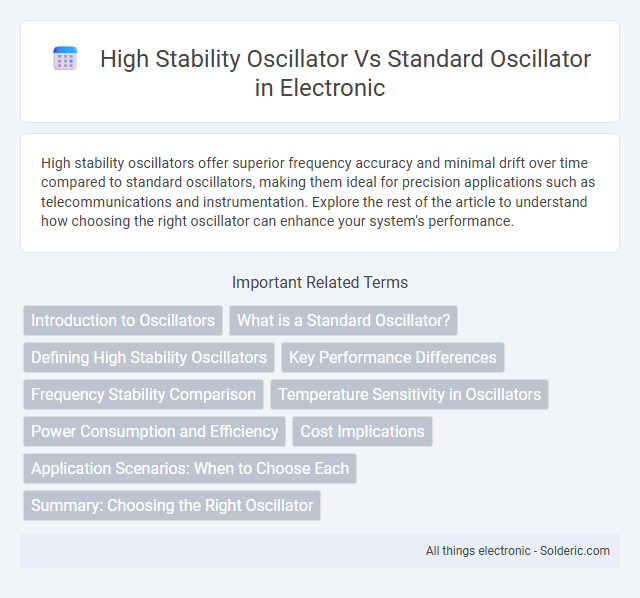High stability oscillators offer superior frequency accuracy and minimal drift over time compared to standard oscillators, making them ideal for precision applications such as telecommunications and instrumentation. Explore the rest of the article to understand how choosing the right oscillator can enhance your system's performance.
Comparison Table
| Feature | High Stability Oscillator | Standard Oscillator |
|---|---|---|
| Frequency Stability | +-0.1 ppm to +-1 ppm | +-5 ppm to +-50 ppm |
| Temperature Range | -40degC to +85degC (or wider) | -20degC to +70degC |
| Frequency Drift | Minimal, often <1 ppm/year | Higher drift, up to 5 ppm/year |
| Phase Noise | Low phase noise suitable for precise timing | Higher phase noise, less precise |
| Applications | Telecom, aerospace, medical devices, precision instrumentation | Consumer electronics, general purpose circuits |
| Cost | Higher cost due to enhanced performance | Lower cost, mass-produced |
| Power Consumption | Typically optimized for stability, may consume more power | Lower power usage |
Introduction to Oscillators
High stability oscillators offer superior frequency accuracy and minimal drift compared to standard oscillators, making them essential for precision applications like GPS and telecommunications. Standard oscillators provide cost-effective solutions with acceptable performance for general electronic devices but lack the enhanced environmental tolerance. Your choice depends on the required frequency stability and application sensitivity to time variation.
What is a Standard Oscillator?
A Standard Oscillator is an electronic component that generates a consistent and stable frequency signal used for timing and synchronization in various devices. Compared to a High Stability Oscillator, it typically exhibits moderate frequency accuracy and stability under varying environmental conditions such as temperature and vibration. Your choice of oscillator depends on the specific precision requirements of the application, with standard oscillators being suitable for general-purpose timing needs.
Defining High Stability Oscillators
High stability oscillators are precision electronic components designed to maintain a consistent frequency output under varying environmental conditions such as temperature, vibration, and aging, offering superior performance compared to standard oscillators. These oscillators often utilize advanced crystal units or temperature-compensated mechanisms to minimize frequency drift, ensuring high accuracy and reliability in critical applications like telecommunications, aerospace, and scientific instrumentation. Your choice of a high stability oscillator can significantly enhance system performance where frequency stability is paramount.
Key Performance Differences
High stability oscillators maintain frequency accuracy within parts per billion over temperature and time, outperforming standard oscillators that typically drift by parts per million. Your applications demanding precise timing, such as telecommunications or aerospace systems, benefit from reduced phase noise and enhanced frequency stability. In contrast, standard oscillators suit less critical environments where moderate frequency variation is acceptable.
Frequency Stability Comparison
High stability oscillators exhibit superior frequency stability, with variations typically less than +-0.1 parts per million (ppm) over wide temperature ranges and extended periods, compared to standard oscillators that often fluctuate by +-10 ppm or more. This enhanced stability results from advanced temperature compensation and precision quartz crystals, making high stability oscillators ideal for telecommunications and precision instrumentation. Frequency drift in standard oscillators can lead to significant timing errors, whereas high stability oscillators maintain consistent frequency, ensuring reliable performance in critical applications.
Temperature Sensitivity in Oscillators
High stability oscillators exhibit significantly lower temperature sensitivity compared to standard oscillators, maintaining frequency stability across a wide temperature range. By using advanced temperature compensation techniques and materials with minimal thermal drift, these oscillators ensure precise signal output crucial for applications like telecommunications and aerospace. Your system's performance can greatly improve by choosing a high stability oscillator when operating in environments with fluctuating temperatures.
Power Consumption and Efficiency
High stability oscillators typically consume more power due to their precise frequency control and temperature compensation mechanisms, which are essential for applications requiring minimal frequency drift. Standard oscillators offer lower power consumption and higher efficiency, making them suitable for general-purpose use where ultra-precise frequency stability is not critical. The trade-off between power efficiency and frequency accuracy should be carefully considered depending on the operational requirements of the device or system.
Cost Implications
High stability oscillators typically incur higher cost implications compared to standard oscillators due to their enhanced precision, tighter frequency tolerance, and improved temperature stability. You may encounter increased expenses in manufacturing, testing, and material quality, which contribute to the premium price. While standard oscillators offer a more budget-friendly option, high stability models provide long-term value where accuracy and reliability are critical.
Application Scenarios: When to Choose Each
High stability oscillators are ideal for precision applications such as telecommunications, GPS systems, and scientific instrumentation where frequency accuracy and minimal drift are critical. Standard oscillators suit general-purpose electronics, consumer devices, and non-critical timing applications where cost and power efficiency are prioritized over extreme precision. Your choice depends on the required frequency stability, environmental conditions, and performance demands of your specific application.
Summary: Choosing the Right Oscillator
High stability oscillators provide superior frequency precision and temperature resilience, making them ideal for critical applications requiring minimal drift. Standard oscillators offer cost-effective performance suitable for general purposes where slight frequency variations are acceptable. Your choice depends on balancing budget constraints with the need for accuracy and stability in your specific electronic system.
High stability oscillator vs Standard oscillator Infographic

 solderic.com
solderic.com